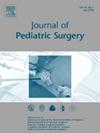Iterative Design and Manufacturing of a 3D-Printed Pediatric Open and Laparoscopic Integrated Simulator for Hernia Repair (POLISHeR)
IF 2.4
2区 医学
Q1 PEDIATRICS
引用次数: 0
Abstract
Background
Inguinal hernia is a common childhood pathology, making inguinal hernia repair (IHR) a key pediatric surgical procedure. Surgical success relies heavily on knowledge of groin anatomy, and both open and laparoscopic approaches require considerable repetition to master. As surgical simulators have been shown to improve performance for other surgical procedures, we developed a combined open and laparoscopic pediatric IHR simulator—named POLISHeR—to train residents, fellows, and practicing surgeons in both types of repair.
Methods
A CT scan of a 7-year-old was scaled down to create a virtual 3D model of a 2-year-old using our validated protocol for anatomical modelling. Physical replicas of the pelvis, abdominal wall, aorta, and inferior vena cava were 3D-printed to create a life-size unisex base for open and laparoscopic IHR, while a small mobile unisex base was 3D-printed for open IHR. We recruited six experienced surgeons and trainees to pilot the face validity of POLISHeR.
Results
After multiple iterations, we successfully developed a modular 3D-printed simulator for open and laparoscopic IHR. Printing the life-size base cost $331.69 USD, whereas the small base cost $17.54. An open modular cartridge cost $9.92 for females and $14.21 for males, whereas replacement parts cost under $1.30. A laparoscopic modular cartridge cost $6.16 for females and $10.91 for males, whereas replacement parts cost $0.28. Pilot study participants provided encouraging feedback with respect to POLISHER's face validity.
Conclusions
Our low-cost simulator holds promise for enhancing training for pediatric IHR. Our next step is to conduct validation trials for trainees and practicing surgeons in both well-resourced and resource-limited settings.
Level of Evidence
Not applicable.
3d打印儿科开放和腹腔镜疝修补集成模拟器(POLISHeR)的迭代设计和制造。
背景:腹股沟疝是一种常见的儿童病症,因此腹股沟疝修补术(IHR)是儿科手术的关键。手术的成功在很大程度上依赖于腹股沟解剖学知识,开腹手术和腹腔镜手术都需要大量的重复操作才能掌握。由于手术模拟器已被证明能提高其他外科手术的效果,我们开发了一种结合开腹和腹腔镜的小儿 IHR 模拟器(命名为 POLISHeR),用于培训住院医师、研究员和执业外科医生两种类型的修复术:方法:使用我们经过验证的解剖建模方案,将 7 岁儿童的 CT 扫描图像按比例缩小,创建 2 岁儿童的虚拟 3D 模型。骨盆、腹壁、主动脉和下腔静脉的实体复制品通过三维打印制作成真人大小的中性底座,用于开腹和腹腔镜 IHR,而小型移动式中性底座则通过三维打印制作成开腹 IHR。我们招募了六名经验丰富的外科医生和实习生,对 POLISHeR 进行面效试验:结果:经过多次迭代,我们成功开发出适用于开腹和腹腔镜 IHR 的模块化 3D 打印模拟器。打印真人大小的底座花费了 331.69 美元,而小型底座花费了 17.54 美元。开腹模块盒的成本为女性 9.92 美元,男性 14.21 美元,而更换部件的成本不到 1.30 美元。腹腔镜模块盒的价格女性为 6.16 美元,男性为 10.91 美元,而更换零件的费用为 0.28 美元。试点研究的参与者对 POLISHER 的面效度提供了令人鼓舞的反馈:我们的低成本模拟器有望加强儿科 IHR 的培训。下一步,我们将在资源丰富和资源有限的环境中,对受训人员和执业外科医生进行验证试验:证据等级:不适用。
本文章由计算机程序翻译,如有差异,请以英文原文为准。
求助全文
约1分钟内获得全文
求助全文
来源期刊
CiteScore
1.10
自引率
12.50%
发文量
569
审稿时长
38 days
期刊介绍:
The journal presents original contributions as well as a complete international abstracts section and other special departments to provide the most current source of information and references in pediatric surgery. The journal is based on the need to improve the surgical care of infants and children, not only through advances in physiology, pathology and surgical techniques, but also by attention to the unique emotional and physical needs of the young patient.

 求助内容:
求助内容: 应助结果提醒方式:
应助结果提醒方式:


